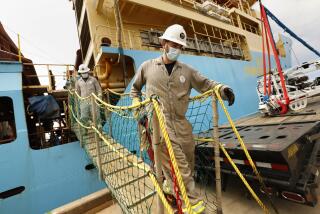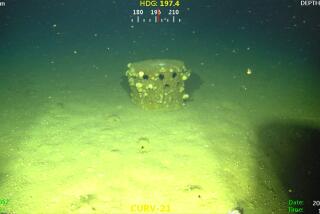‘We’ve never seen this before’: Watch NOAA’s live feed of a hidden, watery world
- Share via
A plume that resembles black smoke billows from a towering underwater chimney. Blind white shrimp rain down in all directions. Pale-colored crabs, squat lobsters and hairy snails cover the patches of ocean floor not already occupied by the thousands of shrimp.
Then, 10,000 feet deep in the ocean’s “midnight zone,” a robotic submarine’s lights and cameras thrust this previously unseen world into prime time.
The robot belongs the National Oceanic and Atmospheric Administration’s Okeanos Explorer, which is now several weeks into a nearly three-month expedition to explore the mysterious deep-water areas around the Marianas Trench Marine National Monument and the Commonwealth of the Northern Mariana Islands.
A key part of the mission is to investigate the unexplored areas of the ocean, said expedition manager Kelley Elliott. The survey focuses on habitats on the top of the Mariana Trench that are about 20,000 feet deep and are less traveled than the deep parts of the trench, which the Okeanos’ equipment can’t reach.
If you think this sounds like something out of Star Trek, you’re not entirely wrong. To the uninitiated, the seafloor and the creatures that live there look positively alien.
Since late April, Okeanos’ remotely operated underwater vehicles have visited ancient coral gardens, a mud volcano and the hydrothermal vents, whose tall spires spew a smoke-like fluid and support a bizarre community of marine life. NOAA is broadcasting the ROVs’ video feed live via YouTube. (You can watch here.)
“A lot of what we’re seeing has never been seen by human eyes before,” deep sea ecologist Diva Amon said by phone from the Okeanos. “That makes us incredibly lucky – and all those viewers who are tuning in very lucky.”
The Okeanos runs 24 hours a day to make the most of the time at sea, Elliott said. During the day the crew explores the region using its two ROVs. At night, the operation uses sonar to map the seafloor.
On the West Coast of the U.S., the time to tune in to the live stream is between 1:30 and 9:30 p.m. The video makes for strangely addicting viewing. There’s a constant cliffhanger: What will they find next?
On one of the expedition’s early dives, the Okeanos stumbled upon a gold-and-red jellyfish while exploring the Enigma Seamount about 12,000 feet under the sea. Amon, who works at the University of Hawaii at Manoa, and a supporting group of over a dozen onshore scientists determined that the jelly belonged to the genus Crossota, and they believe it could represent a species new to science.
On a later dive, the cameras hovered across a vast garden of corals teeming with colorful shrimp, anemones and stars. Many of the same species of corals are mined to make expensive jewelry, and as a result can become threatened, Elliott said.
“That colony is several hundreds of years old, and I’m not sure we should be making jewelry out of things that old,” said Chris Kelley, a UH Manoa biologist watching the dive from one of NOAA’s exploration command centers.
Some colonies of black coral are estimated to be 3,000-4,000 years old, he added.
The dives aren’t all about monstrous-looking crustaceans, translucent tunicates and weird fish, though. The Marianas seafloor holds plenty of surprises for Deborah Glickson, the expedition’s marine geologist.
While surveying a bed of hardened lava 13,000 feet under the sea, a lonely silver-colored shrimp seemed to beg for attention -- but Glickson ignored it. Instead, she focused on the rocks that make up the seafloor. She thinks they’re only about 2 years old.
“We’re on the hunt for some fantastic geology,” she said later on a video.
The newly formed land allows scientists to get a baseline for what the seafloor looks like from the beginning. Scientists can return here on future expeditions to see how long it takes for certain species of corals, crinoids and squat lobsters to colonize an area.
“When you have very fresh new lava flows, you’re essentially resetting the clock on the seafloor,” Glickson said. “It’s all been basically repaved.”
The hydrothermal vents, with their gigantic black smokers and thousands of creepy crawlies, represent the best of both biology and geology.
In the tectonically active Marianas region, colliding continental plates allow cold seawater to drip down into the Earth’s crust. The mineral-rich water becomes super-heated and bubbles out in the form of the black plume. The cold water causes those minerals to harden, building up the tall chimney-like structures of the vent.
Sulfides and methane in the “smoke” feed massive colonies of bacteria that form dense white mats. Instead of plants, the food web around hydrothermal vents relies on these bacteria. Shrimp around the vent are known to farm the bacteria on their bodies and eat them, Amon said. Huge white anemones eat the shrimp.
Like a television news chopper, the ROVs cover the scene with close-ups of the shrimp and other fauna, the gushing vent and a spectacular panning “flyover” of the spire. All the while, the scientists narrate excitedly.
For the crew, it’s a long show and not every dive is equally exciting, Glickson said. But they won’t let it show.
“There’s always going to be someone from the public or the science community that’s going to be fascinated,” she said, “so we need to translate the excitement at all times.”
The video stream hooks tens of thousands of online viewers each day. When the Okeanos was surveying a coral garden, up to 4,000 viewers were tuning in at one time.
The most die-hard enthusiasts follow along and share screen shots and videos with one another on Facebook and interact with the scientists on Twitter.
“When everyone is little they want to be an explorer, and now as adults we all are getting to do this,” Amon said. “I don’t want to get off the ship. I want to do this for the rest of my life.”






